I am forced to wake up at 8, during my half-asleep hour between the alarm of 7:30 and the one of 8:30: a dog jumps on my tent, one small pole falls but it’s enough to have half of the tent roof down. As it rained during the night, the water infiltrates quickly and I’m in emergency mode to pack the sleeping bag and mat before they get wet. Dogs are really the most annoying, if not the most stupid, creatures I have to deal with on the way. That’s also the drawback of sleeping or cycling near habitations, but I can’t avoid that every day.
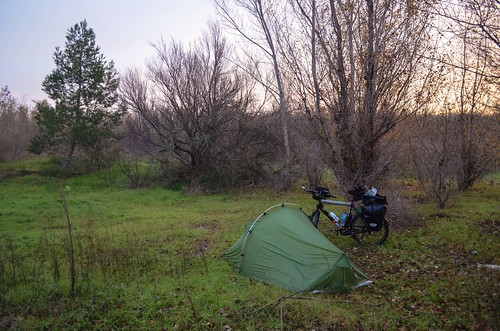
A pizza-breakfast and a chocolate croissant (the first Spanish one I have that is not too dry) later, I’m on the road. I have in mind an itinerary of small roads leading me to the coast. I first cross Santa Barbara, welcomed by a petrol station and a ceramic factory, and continue over Godall and Ulldecona.
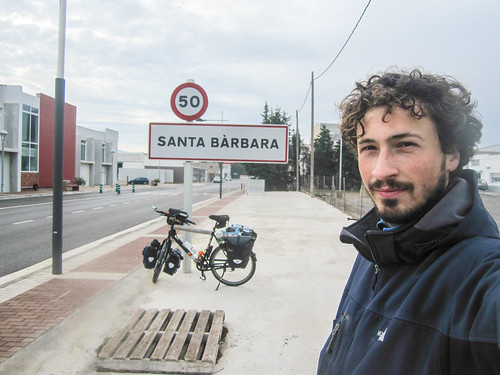
The roadsides are decorated with never-ending orange fields. Like yesterday, the trees are bordering the road and I just have to lift my hand to pick an orange. After trying peeling with the teeth (I get juice sprinkles into my eyes), peeling with two hands on one side of handlebar (making the bike quite unstable), I find the best way is to peel off the oranges in one hand, with the thumb. But it really depends on the oranges, some peel off easily, some not. And my right hand was trained in India to cut chapatis and other food by itself, so the fingers remember how to operate in sync with the others.
I like to eat (or do anything else) while cycling, still in motion. I remember in Thailand, I was touring with a mamachari and a pannier in the front. I could stick anything under the net, I had a map, fresh fruits, coke bottles with straws, and didn’t need to put one foot on the ground.
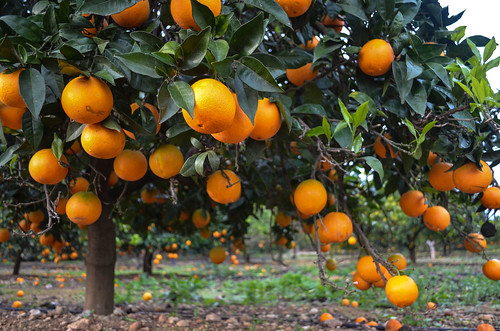

After the first positive impression of having free oranges anytime on my road, I start to feel bad seeing thousands of them on the ground, falling from the branches of the trees bending under the weight of the fruits. There will be some points of the route where I’ll be starving and will have to wait to arrive to a town, while here it’s like a continuous line of free food. I am already making an orange overdose and can’t take many more.
When I am not surrounded by oranges, I am crossing fields of olive trees (but those fruits are not good to eat directly from the tree). Some are older than 1000 years old and speak for the long history of the exploitation of the land.
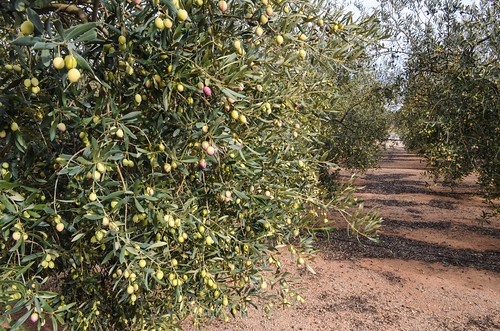
On the narrow road from Godall to Ulldecona, I allow myself a costly pleasure: I put on music. I say costly because it’s a waste of electricity that could be needed later on to charge my GPS or camera batteries, but it’s also special to be in a lonely road with no wind and no noise, hearing only my wheels and the music I put on.

There I find a field with the best oranges (no seeds at all, the peel almost not tied to the fruit chair and falling off easily). I pack the buffer space of a pannier with them.
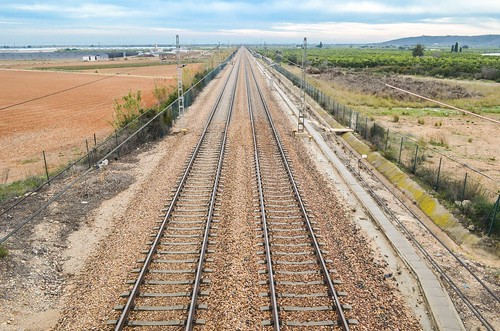

I reach the coast for the first time in Vinarós. It’s the first time my bike sees the sea, having successfully avoided it until now thanks to mountain roads. I prefer mountains to the sea by far, but it’s beautiful to see this infinite water plan. It feels like a “little end” in a way, for putting a boundary to one of my directions. The “big end” will be when 350° of my vision field is occupied by water.

The sky is grey and I receive sprinkles from time to time. Since I progress quite well today, being on a flat land, I stop in a restaurant at the next sprinkle wave. It happens in Benicarló with the menu du jour. I have a 3-course meal for 8.50 €, a good deal. Since I feel I am burning instantly everything ingested, I eat everything on the table, bread, oil, lemon, mayonaise, olives, etc. I’ll be hungry again in less than 2 hours anyway. The thing I stuggle to finish is the wine bottle that comes included in the 8.50 menu … but after all, if miners and farmers had a bottle for breakfast before going to their 12-hour shift, I can do the same.
I borrow a bit of toilet paper too and finish my meal watching the usual bad news on the TV: robberies, Rajoy speeches, Chavez, Tom Cruise in Spain, wind speed above 160 km/h in Galicia and País Vasco … but it doesn’t prevent me to get out again under the light rain until Peñiscola.

This part of the coast is apparently very touristic, but it looks dead to me right now. It’s raining, none of the souvenir shops are open, it’s grey … I don’t stop in Peñiscola and continue straight to the National Park of Serra d’Irta. It is bordering the sea and is crossable only through a gravel road.


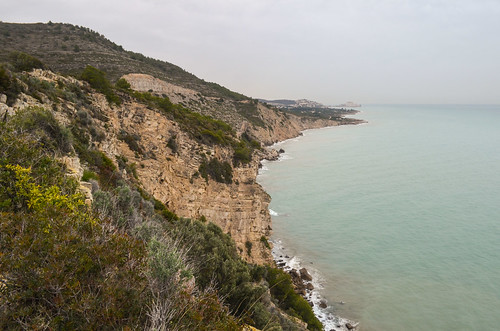
The park is deserted and nice. I make my way slowly and surely on the gravel road over the 10ish kilometers until the next town and the resurrection of the paved road. However, while watching a perfect rainbow going from land to sea, I realize it’s already 5 pm. Time flew and I have to quickly get out of the park, in which camping is prohibited (also, my tent is wet, so I’m not liking the idea either). But the night is catching up on me. A nice sunset is telling me to find a shelter as the gravel road doesn’t allow me to speed out of the park. At dusk, it’s also inconvenient to cycle, there are huge potholes that I see at the last moment, and I could damage something.
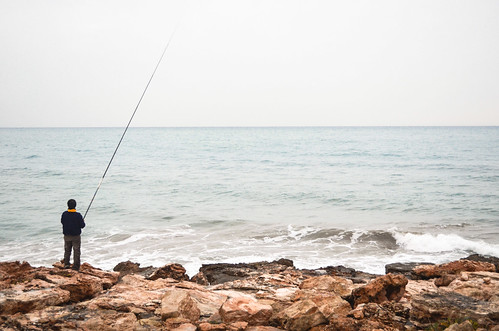
I find a house with a porch under which I build a little house, at the very same moment the rain starts again. The wind also enters the game, it dries my tent, hung under the roof, very quickly. It’s 14°C on my thermometer, the wind is warm, and it does feel good to be comfortable outside, despite the wind, and not to have to dress up with all my clothes and hide somewhere until the next morning.
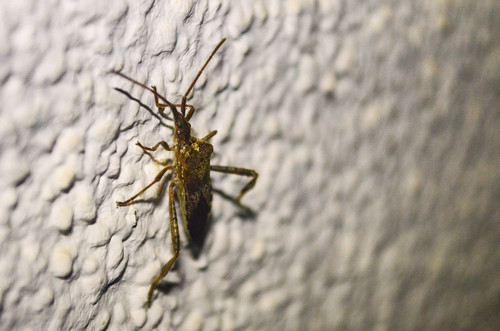
I had roughly 200 km of coastline to cycle until Valencia, and did only 85 yesterday. I estimate then 115 km for the day, and it should be doable if the sky remains dry. I get up, finish my stretch of gravel road, and have breakfast in Alcossebre.

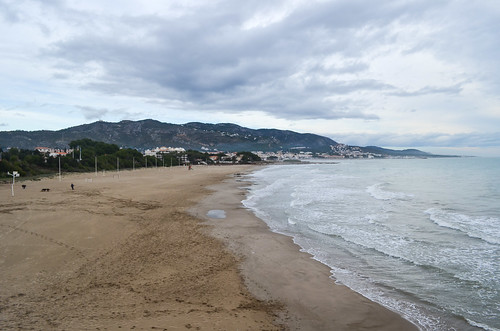
I make my way through a mixture of fields and ghost towns. Some roads are good, some others are bad, but as all the traffic seem to be condensed on the highway nearby, I am most of the time left alone on the asphalt.
I arrive to a dwelt land of campings, and it allows me to fill up my water bottles. It’s strange, suddenly, many many campings together. During a quick chat with one owner, he tells me that the via verde (cycling path) that I though only long of 10 km, is actually going until Valencia. So I should have a car-free road until the end! Well, that’s still close to 100 km to go.
In the camping also, I hear the people talk together in German. It sounds almost a beautiful language after having heard too much Swiss-German. And I tilt: maybe that explains why all the cyclists I was seeing recently didn’t answer to my “hola”s.

Adjacent to the campings, a few hundreds meters further, I fall into a strange scene. The road is long, rectilinear, and wide. Way too wide for being here, it rather looks like an old avenue of a big city. But it is bordered by residential buildings, many of them. All looking empty. I can’t tell if they are abandoned, or being built, or just built but not open yet. The quietness of the place really contrasts with those huge installations, right by the sea.
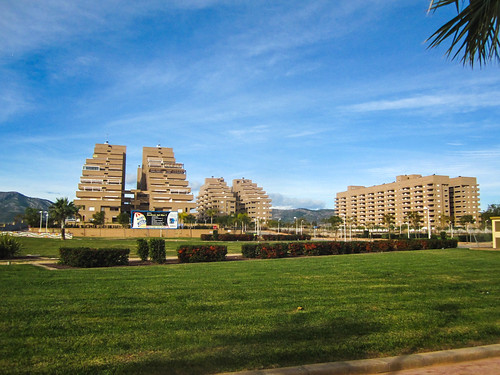
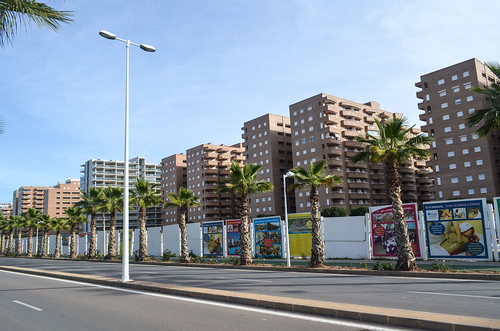
It actually looks like an ugly and empty suburb. I learn later that this residential complex, Marina d’Or, near Oropesa, is more lively in summer. Yet it was built recently with speculations on the housing and tourism economy, making an ugly concrete creature appearing on the coast at the wrong time. I found this harsh article [fr] dealing with the housing waste in the Valencian community.

Once out of this surreal place, once out of Oropesa, I encounter people and nature again. I actually find the via verde of Benicassim by chance. Road indications are not the specialty of the region but when I spot cyclists 2 meters over my head, just by my road, I get it. The via verde is an old railway line converted in a cycling and walking path. It’s very nice.
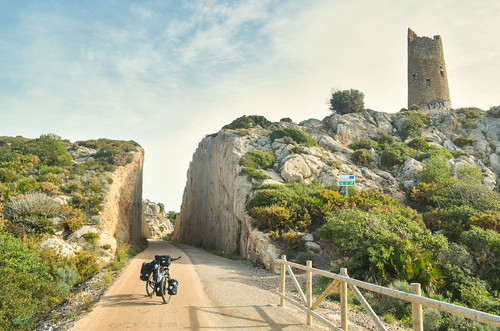

After Benicassim, I realize that the rest of the day will be tougher than expected. The wind blows against me, I have 4 hours of daylight left and more than 60 km to go. It means I won’t stop to eat and have to put more energy in my cycling than my legs want to put.
The road is long …. very long. I enjoy very much the installations made for cyclists: a separate track by the main road, with special crossings at each roundabout. It is perfectly made for cyclists. I don’t have to think of the road and reach Nules.
There, my belly wants food, so I cross carelessly the city until I find a shop open. To my surprise, there are none. Okay, it’s the middle of the afternoon, and everything is closed until 17:00, so I’ll just get something at the shop of the petrol station at the exit of the town. To my surprise again, it’s closed too. It’s saturday … and it seems that if I wanted something, I had to look for it with insistence instead of waiting to bump into it.
Well, I finish my chocolates and continue on the road. The cycling track didn’t re-appear at the exit of the town and I am now on a national road. It is very wide, but not causing me as much discomfort because the traffic is very little. The cars must be on the parallel highway. There are even road cyclists, sign that I am not completely wrong. They’re all going much faster than me and don’t hear me when I ask them for the cycling path until Valencia, mentioned to me earlier by a camping manager. The only cyclist slower than me that I can catch up with and talk to is an illegal immigrant in blue collar from Mali. He has to cycle a long way home but doesn’t know about the vias verde.
Despite pushing well on the pedals, I am not there yet and leave the national road near Sagunto to get back to the coast and follow it until Valencia. I am sure now to arrive at dusk and can’t stop at all.
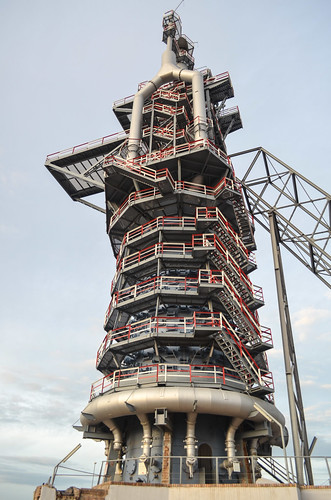
I love having Google Maps on my phone refreshing and zooming on the area I am in. This way, I found a tiny hidden road turning behind a gas power plant at the exit of El Port, after “No trespassing” signs and a segment of the road that mustn’t have been used in a while … I would never have guessed it would lead me to a tiny village by the coast and continuing there, avoiding all the major transit ways a but further from the sea. I doubt also it is mentioned on local maps.
The drawback is that I cannot forecast what will the road be made of. Common sense dictates that if it’s remote from all main roads and has no connections … it could be of dirt. And that is what is happening now, on a gravel road squizzed between the sea and a bird protection area, looking like a giant swamp. It gets worse when the gravel become bigger rocks polished by the sea. I will never get to Valencia if this keeps going on … but my maps indicate a residential area soon.
Once within the houses, the asphalt reappear and I can speed again against the wind to reach the city. It is now night and from my small roads, I can see the light and noise pollution of the highway in the background. I take the opportunity of a last orange field crossing to make a refill of fruits, put on my safety jacket, and head towards the only road available from now on, a big one.
It is more than a big one, it is actually a highway. I can’t (and don’t want to) enter it, but it has fortunately service lanes on both sides, at a lower elevation than the highway itself. I hope that these will lead me until the north of Valencia, where Romulo is waiting for me.
It is not that simple at all. Of the many crossings, some are blocked (road works), and some make me do a long detour. At one time I have the chance to find a small service tunnel passing under the highway to continue my way. I know that I am very close to the city, but the never-ending struggle against the puzzle of the roads, something already annoying by day, becomes a nightmare right now. I wonder many times why I didn’t stay by the coast on the many different locations that would be very suitable for sleeping overnight. Now that I am in that long and unfriendly zone – not anymore the countryside, but not yet the city center – I can’t stop and must finish with it.
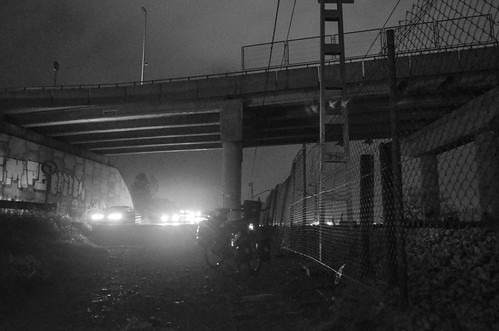
I was setting on 115 km for the day, and am already beyond that. I cross smelly fields, a railway, industrial areas, smelly fields again, and arrive in “proper” Valencia after 2 hours of night ride. Without getting lost, but really underestimated the distance of those suburban installations. I am finally done with the day after more than 135 km, which was way too much and could have easily spanned over 2 days.
I switch from one extreme to another immediately once I reach Romulo’s house. I can rest, shower and eat, and stop watching for cars everywhere.
I stay the next day in Valencia and stroll in the city and around.
Valencia – City of Arts and Science
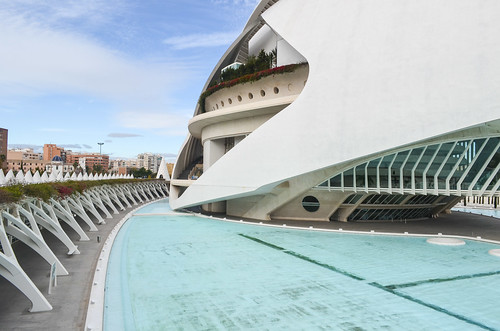

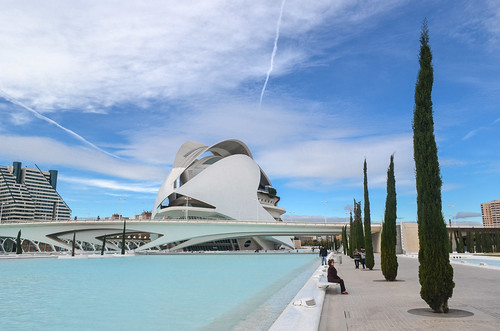
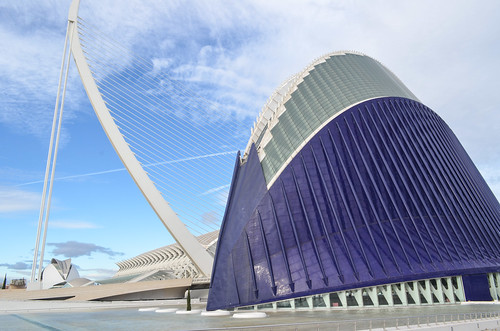









Salut JB tes photos sont toujours magnifiques.
Félicitations pour ton arrivée à Valence.
Bonne continuation
Yep, Alhambra is definitely worth seeing! Hope you manage! 🙂
Am skipping the Alhambra to have a reason to come back!
Went through the Alpujarra instead, it was a permanent amazing landscape.
AlinC
JB , la petite corne de brume (utilisée dans les stades de foot avec la réserve d’air comprimé), il parait que les chiens ont horreur de ce bruit ! je n’ai jamais essayé, mais vu à la télé, dans le dressage des chiens qui courent après les voitures ou les cyclistes . Peut être aussi efficace sur d’autres bestioles en Afrique !
Toujours des belles photos, j’ai l’odeur de la fleur d’orangé en tête.
Valencia semble superbe . Je voyage tous les soirs .A+
Je vais essayer si je trouve en chemin …
JB you should pass through the Alhambra… south from Valencia